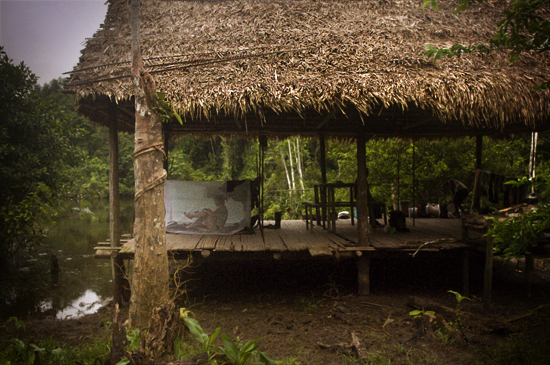Like Iquitos, Santiago de Lagunas (to give the full name) is a jungle town founded by missionaries, in the Amazonian province of Loreto; and like Iquitos, it is a jumping-off point for visiting the surrounding rainforest, especially the Pacaya-Samiria Reserve.
Pacaya-Samiria guide with hitchhiker!
But, even though Lagunas is nearly 100 years older than Iquitos, having been founded in 1670 by a priest, Juan Lorenzo Lucero, it has a fraction of the population and receives a fraction of the visitors.
That, no doubt, has much to do with the remoteness: Lagunas can only be reached along the Huallaga River, with a journey downstream from Yurimaguas taking at least four hours by speedboat.
The area around Lagunas is home to the Kokama (also spelt Cocama and Kukama), an indigenous group numbering around 15,000 in Peru's Upper Amazon region and over the border in Colombia and Brazil.
They maintain many of their religious and cultural traditions, despite the impact of European colonisation and diseases, Christian evangelisation and the decline of their language, Kukama-Kukamiria.
The corrugated iron roofs of Lagunas from the air.
The town itself is nondescript, with typically basic Amazonian housing lining dirt roads. At time of writing there is limited electricity, no cash machines, and only one road is tarmacked.
However, the locals are delighted to receive visitors; and Puesto de Vigilancia (Ranger Station) #8 is only a 30 minute ride away by mototaxi, at Baradero de Tibilo. This is an entrance point into the north-western section of the enormous Pacaya-Samiria Reserve.
Accommodation in Pacaya-Samiria Reserve.
Whereas the north-eastern section of the Reserve - where the Ucayali and Marañon Rivers come together to form the Amazon River - boasts comfortable lodges and luxurious cruise boats, the infrastructure on the other side is less developed.
Travel is by dug-out canoe; accommodation is in rustic refuges or campsites; cooking is done on an open fire; and washing is done in the river.
The attractions are obvious: with fewer visitors and less river traffic, the flora and fauna is more varied and widespread. And for those keen to experience a wilderness destination, truly separated from nearly all the trappings and noise of modern life, this should be on your list.
Bathtime in Pacaya-Samiria Reserve.





